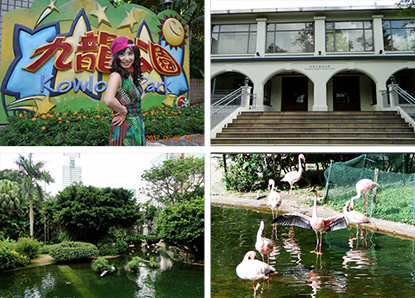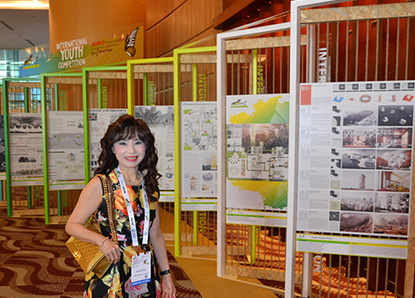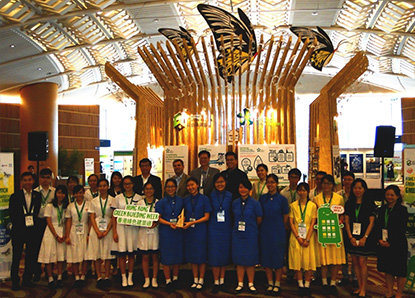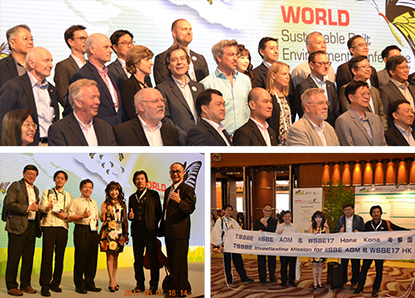Participation in WSBE17 Hong Kong & iiSBE meeting (Part: 4)
 6月7日利用會前空檔,前往九龍公園參觀,這裡曾經是林則徐先生在鴉片戰爭期間督促建立砲台的所在地。現在因為擁有大片樹林,所以吸引許多鳥類前來駐足,包含火鶴、天鵝及番鴨等。公園內還有一座由英軍營房改建而成的「香港文物探知館」,及九龍地區唯一適合舉辦國際賽事的露天游泳池。 6月7日利用會前空檔,前往九龍公園參觀,這裡曾經是林則徐先生在鴉片戰爭期間督促建立砲台的所在地。現在因為擁有大片樹林,所以吸引許多鳥類前來駐足,包含火鶴、天鵝及番鴨等。公園內還有一座由英軍營房改建而成的「香港文物探知館」,及九龍地區唯一適合舉辦國際賽事的露天游泳池。On June 7, when no activity was arranged, the delegation visited the Kowloon Park where a fort was built during the Opium War of 1840 under the supervision of Lin Zexu, Viceroy of Liangguang. Today, the large forest in the park has attracted different kinds of birds, such as the flamingo, the swan and the Muscovy duck. Inside the park, there was The Hong Kong Heritage Discovery Centre refurbished from a former British Army barrack and the only open-air swimming pool for international events in Kowloon.  6月7日的會議共有212人次的演說論文發表,演講內容是以建築材料為主。目前最環保的建材是木頭,可說是“減碳最佳的建材”,但依照樹種不同,也有不同的用途,諸如:大型檜木、喬木與竹子,都有其不同的特徵屬性,可以依照屬性來架構出良好的“樹屋”或木屋。另外,也有針對屋頂在覆上一層材料來反射陽光,達到降低室內溫度的效果。零能源建築並不是指完全不使用能源,而是能源產生與消耗能達到相等的程度,能源產生的管道目前已知不少,主要還是以太陽能板與植物及藻類為主。其中本團成員李讃虔先生所投稿的內容就是以德國漢堡市的藻類綠建築為基礎,再往前發展出藻類的多功能性,利用選種及改變培養環境的方式,讓藻類綠建築能成為多功能生產型建築物,而不再是目前已達到“零耗能”水準的藻類綠建築。這種導入生物多樣性及生物資源的構想,未來勢必也會有人提出相關構想。 6月7日的會議共有212人次的演說論文發表,演講內容是以建築材料為主。目前最環保的建材是木頭,可說是“減碳最佳的建材”,但依照樹種不同,也有不同的用途,諸如:大型檜木、喬木與竹子,都有其不同的特徵屬性,可以依照屬性來架構出良好的“樹屋”或木屋。另外,也有針對屋頂在覆上一層材料來反射陽光,達到降低室內溫度的效果。零能源建築並不是指完全不使用能源,而是能源產生與消耗能達到相等的程度,能源產生的管道目前已知不少,主要還是以太陽能板與植物及藻類為主。其中本團成員李讃虔先生所投稿的內容就是以德國漢堡市的藻類綠建築為基礎,再往前發展出藻類的多功能性,利用選種及改變培養環境的方式,讓藻類綠建築能成為多功能生產型建築物,而不再是目前已達到“零耗能”水準的藻類綠建築。這種導入生物多樣性及生物資源的構想,未來勢必也會有人提出相關構想。On June 7, 212 participants presented papers, with speeches focusing on construction materials. Currently, wood is the eco-friendliest construction materials and considered as "a material with the best carbon reduction effect." However, the usage of wood varies by species. For example, we can build good "tree houses" or log cabins with the cypress (Cupressaceae), arbors, and bamboo based on the species-specific properties. In addition, a light-reflecting coating can be painted on the roof surface to reflect sunlight so as to reduce indoor temperature. A zero-energy building does not really mean zero energy consumption. Instead, it means a build that can produce energy equivalent to the consumption. There are many ways known for energy production, and solar panels, plants, and algae are the most common among others. In his paper, instead of the "zero-energy" algae-powered building, Mr. Li Tsan-chien of Archilife recommended the diversification of algae functions to turn algae-powered buildings into multifunctional, productive buildings with the algae-powered building in Hamburg, Germany, as an example. Related ideas of combining biodiversity and biomass resources will surely be introduced in the future.  午餐時段,大會安排了一場高中生以「齊齊行動紓緩氣候變化」為題的英語演講比賽,讓年輕學子們也有機會參與環境永續的議題。其次,大會也展示了這次會議專用袋上的圖案,其實是小學生在香港綠色建築週「綠色香港:我家‧我城」繪畫比賽的冠軍作品。將同學的創意變成大會送給來自世界各地專家的「紀念品」。 午餐時段,大會安排了一場高中生以「齊齊行動紓緩氣候變化」為題的英語演講比賽,讓年輕學子們也有機會參與環境永續的議題。其次,大會也展示了這次會議專用袋上的圖案,其實是小學生在香港綠色建築週「綠色香港:我家‧我城」繪畫比賽的冠軍作品。將同學的創意變成大會送給來自世界各地專家的「紀念品」。 At the lunch break, the organizer arranged an English speech contest themed "Act On Climate Change - Together, Now!" for young students to take part in environmental sustainability. In addition, the organizer also demonstrated the pattern on the conference kit pack. It is the champion work of the art contest entitled "Green Hong Kong: My Home and My City" organized by HKGBC. That is, the organizer presented the creativity of students as the "souvenir" of experts across the world. At the lunch break, the organizer arranged an English speech contest themed "Act On Climate Change - Together, Now!" for young students to take part in environmental sustainability. In addition, the organizer also demonstrated the pattern on the conference kit pack. It is the champion work of the art contest entitled "Green Hong Kong: My Home and My City" organized by HKGBC. That is, the organizer presented the creativity of students as the "souvenir" of experts across the world.下午場次的演講內容,除了生物相關建材外,也有利用礦物的特質進行二氧化碳吸附後,使結構更為緊密的材質,對於環境永續與新科技的發展皆有很大的助益。利用具有超吸附力與聚合功能纖維,使水泥狀的建材能夠進行自我修復。其次也有利用動態玻璃來調節光線照射進入室內角度與光強度的技術,可以有效的穩定室內溫度,降低能源消耗。 In the afternoon speeches, apart from bio-related construction materials, some proposed the use of minerals to absorb carbon dioxide to fortify material structure, which can benefit both sustainable environment and new technology development. Fibers with absorption and polymerization functions enable the self-repair of cement-typed construction materials. Some suggested using dynamic glass to adjust the angle and strength of light entering the dwelling to effectively stabilize indoor temperature and reduce energy consumption.  在所有會議結束後,本屆的大會也隨著閉幕式進入了尾聲。在閉幕式上,由來自加拿大卑詩大學建築及園藝建築學系的Raymond Cole教授再次強調了全球暖化的現象仍在持續進行,所延伸出來的氣候劇烈變化,將會導致地球各處發生嚴重災難,此有賴於各國政府間的相互合作,共同讓地球生活環境得以永續。最後則由Mr. Nils Larrson宣布:下一屆永續建築國際會議WSBE20將在2020年6月9至11日於瑞典第二大城哥特堡Göteborg舉辦。黃秘書長也以iiSBE總會台灣理事身分在閉幕典禮上台與大會重要人物合照,顯示台灣在這次會議上,依舊能站穩自己的腳步並獲得尊重。 在所有會議結束後,本屆的大會也隨著閉幕式進入了尾聲。在閉幕式上,由來自加拿大卑詩大學建築及園藝建築學系的Raymond Cole教授再次強調了全球暖化的現象仍在持續進行,所延伸出來的氣候劇烈變化,將會導致地球各處發生嚴重災難,此有賴於各國政府間的相互合作,共同讓地球生活環境得以永續。最後則由Mr. Nils Larrson宣布:下一屆永續建築國際會議WSBE20將在2020年6月9至11日於瑞典第二大城哥特堡Göteborg舉辦。黃秘書長也以iiSBE總會台灣理事身分在閉幕典禮上台與大會重要人物合照,顯示台灣在這次會議上,依舊能站穩自己的腳步並獲得尊重。The closure of WSBE17 Hong Kong was drawing near as all meeting ended. In the closing ceremony, Professor Raymond Cole of the School of Architecture and Landscape Architecture, University of British Columbia, Canada, re-stressed that global warming is still in progress, and the resulting extreme weather change will cause severe disasters in all parts of the world. Therefore, it needs intergovernmental cooperation to sustain the living environment on the Earth. Lastly, Mr. Nils Larrson announced that the next World Sustainable Built Environment Conference (WSBE20) will be held in Göteborg, the second largest city of Sweden, during June 9-11, 2020. Secretary General Huang also took pictures with the conference VIPs on the stage as an iiSBE director from Taiwan. This suggests that Taiwan has successfully maintained its pace and earned global respect at the conference. |

